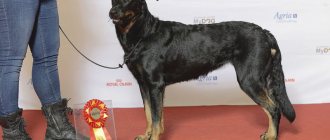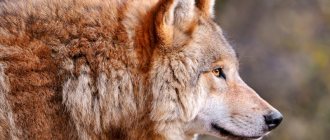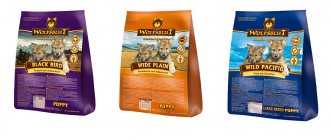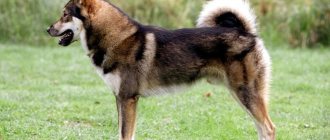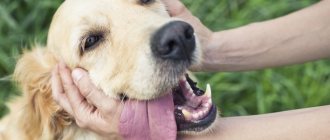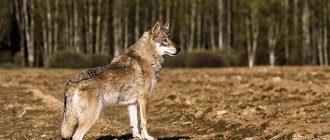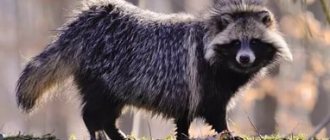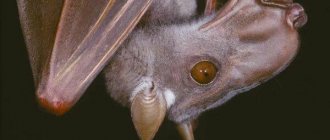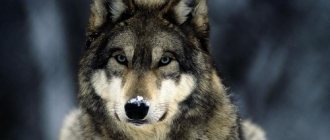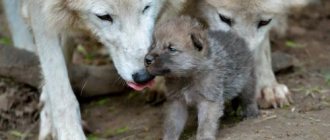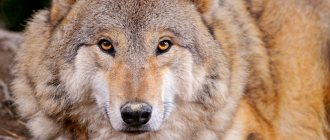Czechoslovakian Wolfdogs are large, harmoniously built animals with slanting amber eyes and straight, thick grayish hair. The manner of movement and the characteristic light mask on the muzzle give them a resemblance to wolves, and their endurance and reaction speed help them compete with other service animals. Let's find out what the Czech wolfdog is and what features are hidden behind its “animal” appearance.
Breed description, standards, appearance
The Czechoslovakian Wolfdog or Czechoslovakian Wolfdog is a strong, well-proportioned animal with a moderately elongated body and well-developed muscles.
According to the international classification, the breed is classified in group 1 “Guard and racing dogs”, section 1 “Shepherd dogs” with testing of working skills.
Czech Wolfdog - size and constitution
The Czechoslovakian Wolfdog is a large breed with pronounced sexual dimorphism. The minimum height of a female is 60 cm at the withers with a weight of 20 kg. The male grows no lower than 65 cm with a weight of 26 kg.
According to FCI standard No. 332, a typical Czechoslovakian Wolfdog must meet the following description:
- The head is well developed, proportional, and has the appearance of a blunt wedge. The skull is slightly rounded with a poorly defined frontal groove and a clearly visible occipital protuberance. The stop is moderately pronounced. The muzzle is not wide, clearly defined with a level bridge of the nose and a black oval nose. The jaws are developed, covered with tightly fitting lips without “pockets” in the corners of the mouth. The teeth are correctly set and fully equipped. Scissor bite or straight bite.
- The eyes are small, slanted, with amber irises and dry, tight-fitting eyelids.
- The ears are erect, triangular, short, thin. The outer corner of the shell is in line with the outer corner of the eye.
- The body is moderately elongated with pronounced withers, a flat, strong back, a short, slightly convex loin and a developed, almost horizontal croup. The chest is pear-shaped and does not fall below the elbow joints. The abdomen is elastic, tucked with slightly sunken sides.
- The limbs are strong, level, close-set with wide, slightly turned out paws, long arched toes, dark, elastic pads and hard, well-pigmented nails. The movements are soft, light, harmonious. Typical gaits are trot and amble.
- The tail is set high and hangs vertically down. In a state of excitement, it takes on a crescent shape and rises upward.
The deficiencies in the presence of which the Czechoslovakian Wolfdog will not receive the highest judge's score include:
- black, dark brown or different eyes;
- large, high/low set ears;
- too light/heavy head;
- flat forehead;
- high/low neck;
- undefined withers;
- incorrect topline;
- long, low-set, irregularly carried tail;
- insufficient/excessively pronounced angles of the front or hind limbs;
- long croup;
- weak pasterns.
The defects that, if detected, exclude the Czechoslovakian Wolfdog from breeding, include:
- atypical movements;
- weak ligaments;
- incorrectly positioned forelimbs;
- incorrect landing and position of the tail;
- irregular chest;
- sharp slope of the croup;
- suspension;
- incorrect shape and placement of ears/eyes;
- irregular head shape;
- disproportionate addition;
- cryptorchidism (in males);
- bite defects;
- missing teeth except one M3 and two PM
Czech Wolfdog - color and coat type
The Czechoslovakian Wolfdog has a thick, straight coat, the density of which depends on the season. In winter, it becomes overgrown with abundant undercoat, evenly distributed over the entire body, including the space between the toes, the inside of the ears, the scrotum, the backs of the thighs and the abdomen.
The Czechoslovakian Wolfdog's color ranges from silver-gray to yellowish-gray with a characteristic lightened mask. Light hair is desirable on the front of the chest and the inside of the neck. Any other color variations and the absence of a light mask are considered a serious defect.
Character and behavior
The Czechoslovakian Wolfdog has a unique character, which combines the habits of a predatory animal and a domestic dog. Submitting to natural instincts, he perceives the master's family as a pack with a clear hierarchy. The dog chooses one owner, whom he recognizes as the leader, and unconditionally obeys him.
In the absence of such a leader, the Czechoslovakian Wolfdog becomes capricious and uncontrollable. Therefore, it is extremely risky to take him into families where there is no person with experience in raising representatives of serious service breeds.
Despite being selective in obedience, the Czechoslovakian Wolfdog recognizes all family members and, if necessary, rushes to protect them. Moreover, at such moments, neither the size nor the number of attackers is important to her.
The Czechoslovakian Wolfdog is extremely wary of strangers and carefully watches all their movements. At the command of the owner, she can relax her vigilance a little, but she will never completely trust strangers.
The Czechoslovakian Wolfdog has well-developed not only guarding, but also territorial instincts. Therefore, she makes an excellent watchman and bodyguard.
On a note. Due to its nature, the Czechoslovakian Wolfdog has a hard time getting used to even new family members and does not always accept them. Therefore, it cannot be given into the wrong hands.
Breed and children
The Czechoslovakian Wolfdog is not affectionate towards children and places itself above them in the hierarchical system. She reacts very strongly to disrespect and will not tolerate being cuddled or attempted to be ridden. Therefore, adopting a Czechoslovakian Wolfdog into families with children growing up is very risky.
Breed and other animals
The Czechoslovakian Wolfdog is a dominant dog with strong leadership abilities. Therefore, he is not ready to share his territory with same-sex brothers. If you decide to place a second dog in the house where the Czechoslovakian Wolfdog lives, it is better to take a representative of the opposite sex.
A dog gets along with small animals only if it grew up with them. The wolfdog's loyalty does not extend to other people's cats and rodents.
Health
Characteristic diseases
This breed has real wolf health; there are no hereditary diseases yet.
There is some predisposition to hip dysplasia, but with proper care and a balanced diet, the dog will not bother its owners with any ailments.
The dog can understand by gestures and facial expressions what state the owner is in and, if necessary, take the necessary measures
Vaccinations
Wolfdog needs the same vaccinations that are given to German Shepherds:
- 1st vaccination – approximately in a month;
- 2nd – about 3-4 weeks after the first;
- 3rd – after replacing all teeth.
Further vaccination is carried out once annually. Before it, you need to make sure that the dog is in good health and carry out deworming 7-10 days in advance.
If you are interested in how to determine if your dog has worms, we recommend reading the following article:
Being with your family and receiving signs of attention is a pleasure for your wolf! However, if he sees that his family has no time for him, the dog will not impose himself
Brief history of origin
This is a relatively young breed, developed by a group of Czechoslovakian breeders in the 1950s. The reason for its appearance was a sharp increase in demand for guard dogs capable of serving on the border.
In most European countries, German Shepherds were used to do this work, but they “retired” too early. After 8 years, the dogs’ sense of smell became significantly dulled, visual acuity dropped, and their reaction time when apprehending violators slowed down, which prevented them from competing with young individuals.
In order to increase the endurance of the service population, they decided to infuse the German Shepherd with the blood of the Carpathian wolf. Colonel Karel Hartl, who had previously worked on improving the exterior of Czech terriers, was appointed head of the group of breeders. The parents of the first litter of hybrids, which appeared in 1958, were the she-wolf Brita and the German Cesar.
The second time, Brita was mated to a dog named Kurt. Puppies from both litters turned out to be quite viable and met the criteria. Therefore, the experiments were continued, but in a slightly modified form: the mother of the offspring was a female German shepherd, and the father was a Carpathian wolf.
Cynologists continued to further develop the working qualities of representatives of the new breed, which was reflected in the temperament of the animals. As a result, the Czechoslovakian Wolfdog moved from the service category to the generalist category.
The first breed fan club was founded in 1982. And in 1989, the Czechoslovakian Wolfdog received an approved standard.
Czech Wolfdog: interesting facts
Despite the relative youth of the breed, a lot of interesting things can be said about the Czechoslovakian Wolfdog:
- the formation of the phenotype took place during the existence of the Czechoslovak Republic. Therefore, now two countries are vying for the right to be called the birthplace of the breed - the Czech Republic and Slovakia.
- It is believed that the Czechoslovakian Wolfdog cannot bark. It uses whining, growling, howling and body language as its means of communication.
- Czechoslovakian Wolfdogs are very hardy animals about which legends are made. History knows several cases when they easily covered a distance of a hundred kilometers, moving at a speed of 12 km/h.
- The Czechoslovakian Wolfdog is not considered a potentially dangerous wolfdog-type hybrid to humans. The last time predator blood flowed into the breed was in 1983.
Principles of education
People who are thinking about just such a pet should take into account the characteristics of character, care and upbringing. Therefore, to keep a Czech wolf dog you need experience with large breeds.
Wolfdog puppies
In the first months of life, puppies exhibit hunter traits, which must be stopped immediately. A well-trained Czech Wolfdog is indifferent to wild animals.
Proper education is provided by socialization courses. If an animal is isolated, it develops aggression. At approximately 9–14 months, the period of teenage rebellion begins.
Without socialization, dogs develop aggression
The principles of training are the same as for service breeds. The Czech Wolfdog is dependent on motivation. He gets tired quickly, but if the trainer finds the right approach, then the pet is ready to give his all. The breed is considered capable of agility, obedience, and easily learns many tricks.
Reference. The Czech Wolfdog has a canter gait. The dog moves easily and naturally.
Often when training, difficulties arise with following commands where you need to give a voice. This type of dog does not communicate through barking. The Wolfhund can growl, whine, and grunt. The main way of communication is body language.
Outdoor training
You can find out more about the methods and methods of training dogs of various breeds in a special section on our website.
Care and maintenance
Czechoslovakian wolf dogs are undemanding to space and can live both in an enclosure and in an apartment. True, in the latter case, animals need regular physical activity.
To prevent the Czechoslovakian wolfdog from destroying the apartment and howling, it should not be left alone for a long time. If the owners need to leave the house, the dog is thoroughly exhausted with a walk and locked in a strong cage with a secure lock.
Hygiene procedures
The coat of the Czechoslovakian Wolfdog requires standard care. In normal times, it is treated several times a week with a special brush. During the period of seasonal molting, accompanied by abundant separation of the undercoat, the wolfdog is scratched daily with a furminator or slicker brush.
The coat of the Czechoslovakian Wolfdog has dirt-repellent properties and does not require frequent washing. Bath the animal using veterinary shampoos only in case of severe contamination, but not more than 4 times a year.
The erect, open ears of the Czechoslovakian Wolfdog quickly accumulate dirt. To prevent otitis, they are cleaned weekly with cotton swabs soaked in chlorhexidine, a special lotion or hydrogen peroxide.
The eyes of the Czechoslovakian wolfdog are wiped daily to remove natural secretions with a clean natural cloth moistened with chamomile decoction or strong unsweetened tea. If they begin to fester, tear or turn red, the dog is taken to the veterinarian.
The claws of the Czechoslovakian Wolfdog usually wear down naturally. But if this does not happen, they are shortened as necessary with special cutters so that they do not interfere with the dog’s walking. Manipulations with a nail clipper are carried out extremely carefully, trying not to injure the blood vessels.
The Czechoslovakian Wolfdog's teeth are brushed 2-3 times a week with a soft brush and veterinary paste. To prevent the formation of stones, she is systematically given various chews, such as beef bones or hard raw vegetables.
Czech Wolfdog - feeding
The Czechoslovakian Wolfdog is not picky about his diet and eats with appetite everything that is in his bowl. To replenish lost energy, an active dog needs a high-protein diet, including at least 70-80% raw, sinewy meat.
It is better if it is beef, lean lamb, rabbit or turkey. A couple of times a week, meat feeding can be replaced with sea fish fillets or offal, such as liver, heart, tripe or kidneys.
It is also recommended to give the Czechoslovakian Wolfdog:
- eggs;
- cereals;
- vegetables;
- sour milk.
To prevent diseases of the digestive system of the Czechoslovakian wolfdog, exotic fruits, smoked meats, sweets, pickles, spices, fatty meats and any dishes from the common table are contraindicated.
On a note. If the Czechoslovakian Wolfdog eats natural products, its diet is additionally fortified with fish oil, flaxseed oil and brewer's yeast.
If the owners’ plans do not include preparing food for the pet, it can be switched to ready-made industrial food. To ensure that the Czechoslovakian Wolfdog does not lack nutrients, they buy premium or super-premium imported dried food, such as Bozita, Orijen, Belcando or Acana. When choosing food, it is important to consider that the dog’s body does not digest starch, which is often found in industrial products.
Walking and exercise
The Czechoslovakian Wolfdog is endowed with extraordinary endurance and an energetic temperament. So that she does not suffer from lack of exercise, you need to walk her twice a day for at least 1.5 hours.
To realize its working potential and maintain muscle tone, the Czechoslovakian Wolfdog can be occupied with playing ball, lightly towing objects, running behind a bicycle or riding in a sled.
Important! In the absence of systematic physical activity, the Czechoslovakian Wolfdog becomes uncontrollable. What the dog lacks in movement, it makes up for with annoying howling and pogroms.
Czech wolfdog - training and education
The Czechoslovakian Wolfdog has high intelligence, but its independence and obvious leadership abilities greatly complicate the educational process.
She does not accept useless activities and is not ready to carry out repeated commands. In order for a dog to show interest in learning, it must have a good motivator, in the form of a favorite treat, toy, etc.
In order for the Czechoslovakian Wolfdog to be well controlled in everyday life, it is advisable to go through a general training course with him. And if a dog is needed for protection, it must be trained as a ZKS.
Puberty and mating
Czechoslovakian Wolfdogs become sexually mature at 7-11 months, but are fully formed only by two years. Therefore, it is recommended to untie them no earlier than 2 years.
Only absolutely healthy, purebred Czechoslovakian dogs under 8 years of age with a stable psyche and standard exterior are selected for breeding. Mating is carried out on the 10-13th day from the start of estrus and is repeated 1-2 days later. So that the male Czechoslovakian Wolfdog does not feel confused, mating should take place on his territory. Before mating, the animals are not fed and are given a good walk.
Pregnancy in Czechoslovakian Wolfdogs lasts about two months and ends with natural birth. On average, litters contain 6-9 puppies.
Caring for puppies
A Czechoslovakian Wolfdog puppy from a good kennel moves to a new home after he is 2-3 months old. Therefore, future owners can slowly prepare a “dowry” kit, which includes:
- bed with replaceable covers;
- bowls for food and water;
- various toys;
- hygiene products;
- walking equipment;
- disposable diapers;
- grooming tools.
The puppy's resting place is located away from drafts and heat sources. To prevent an inquisitive wolfdog from getting injured while exploring a new home, household chemicals, medications, electrical wires and fragile objects are removed from him in advance.
To protect the puppy from infections, he is not allowed outside and is protected from contact with other people’s animals until he is fully vaccinated and has served the required quarantine.
The main thing is space
The Czechoslovakian Wolfdog needs space, so a small apartment is not suitable for keeping. If there is insufficient physical activity, the dog may show aggression and anger. If it is not possible to provide other living conditions, then the owner must take care of regular walking lasting at least 60 minutes with physical activity. The best option for this breed is a private yard with an aviary.
A dog can live in a cage all year round
Wolf dogs shed twice a year. Then they are combed daily. Ignoring the procedure leads to the development of dermatological diseases - for example, eczema, mycoses.
Dogs kept outside are washed twice a year in warm weather. Ear cleaning is carried out only if a lot of wax has accumulated. There is no need to trim the claws: they wear down during walks.
There are many toothpastes for dogs on the market.
Monitoring the condition of the oral cavity is necessary. When the dentition changes from baby to permanent, tug-of-war exercises are canceled and replaced with fun with special toys from the pet store. Teeth cleaning is carried out once every three to four days with special pastes. In older individuals, if hygiene is not observed, tartar forms.
Attention! Human oral care products are not suitable for dogs.
How to choose a pet
The Czechoslovakian Wolfdog is a rare breed. The average cost of such a puppy from titled producers is 55-60 thousand rubles.
To avoid becoming the owner of a mestizo, when choosing a potential pet you should pay attention to:
- presence of stamp and documents;
- compliance with the breed standard;
- character traits;
- health status;
- conditions of detention.
If a puppy is taken for breeding and participation in exhibitions, its parents, in addition to pedigrees, must have tests for the presence of genetic diseases, grading code data and the results of the T1 psychological test.
Price
There are several nurseries in Moscow where you can buy wolfdogs. Look for the coordinates of the clubs: “Best dog clib IKU” with “Vicdogclab”. There are others. The club will tell you in detail about the characteristics of this breed and recommend a kennel. Wolfdogs are a rare breed and they cost about 1 thousand euros.
Each nursery may have its own cost. It depends on the blood, the class of the puppy, whether the parents are titled or not and how rare the blood is for the country.
Do you want to buy a dog cheaper? Go to Slovakia. See the sights of the country and the choice of puppies will be greater than in Moscow. Total costs may be higher.
Czech Wolfdog: pros and cons of the breed
To prevent your long-awaited pet from joining the ranks of abandoners in a few months, before purchasing you need to adequately weigh the main pros and cons.
| pros | Minuses |
| Pleasant appearance | Independence |
| Developed security qualities | Need for training and exercise |
| Integrity |
Czechoslovakian Wolfdogs are large animals that combine the working qualities of a shepherd dog and the endurance of a wolf. They have proven themselves well as servants and are increasingly found in ordinary families as pets.
Feeding your pet
It is better to feed your dog not natural food, but pet food. They are well adapted to ready-made food, and there are no problems with digestion. It is better to buy a proven brand. All products are already balanced and do not require additional additives. Adults eat 2 times a day, puppies 4 - 5 times a day.
When preparing natural food, you should pay attention to the increased protein content. Its size should be determined by the following formula: 30 grams per 1 kg of shepherd’s weight.
In addition, fish, eggs, dairy products and fruits/vegetables/herbs should be fed. Cereals make up the smallest percentage of the total weight, with vegetables/greens making up about 20%. Vitamin and mineral complexes are chosen as a supplement.
Walking dogs often have food allergies, so it is recommended to use ready-made food.
